I’ve been making no-knead homemade artisan bread for the last 15 years, and it’s always been good but never quite what I hoped it would be. It just wasn’t quite right.
Of course, it was still delicious, and we enjoyed the homemade bread, but it always left me thinking it could be better.
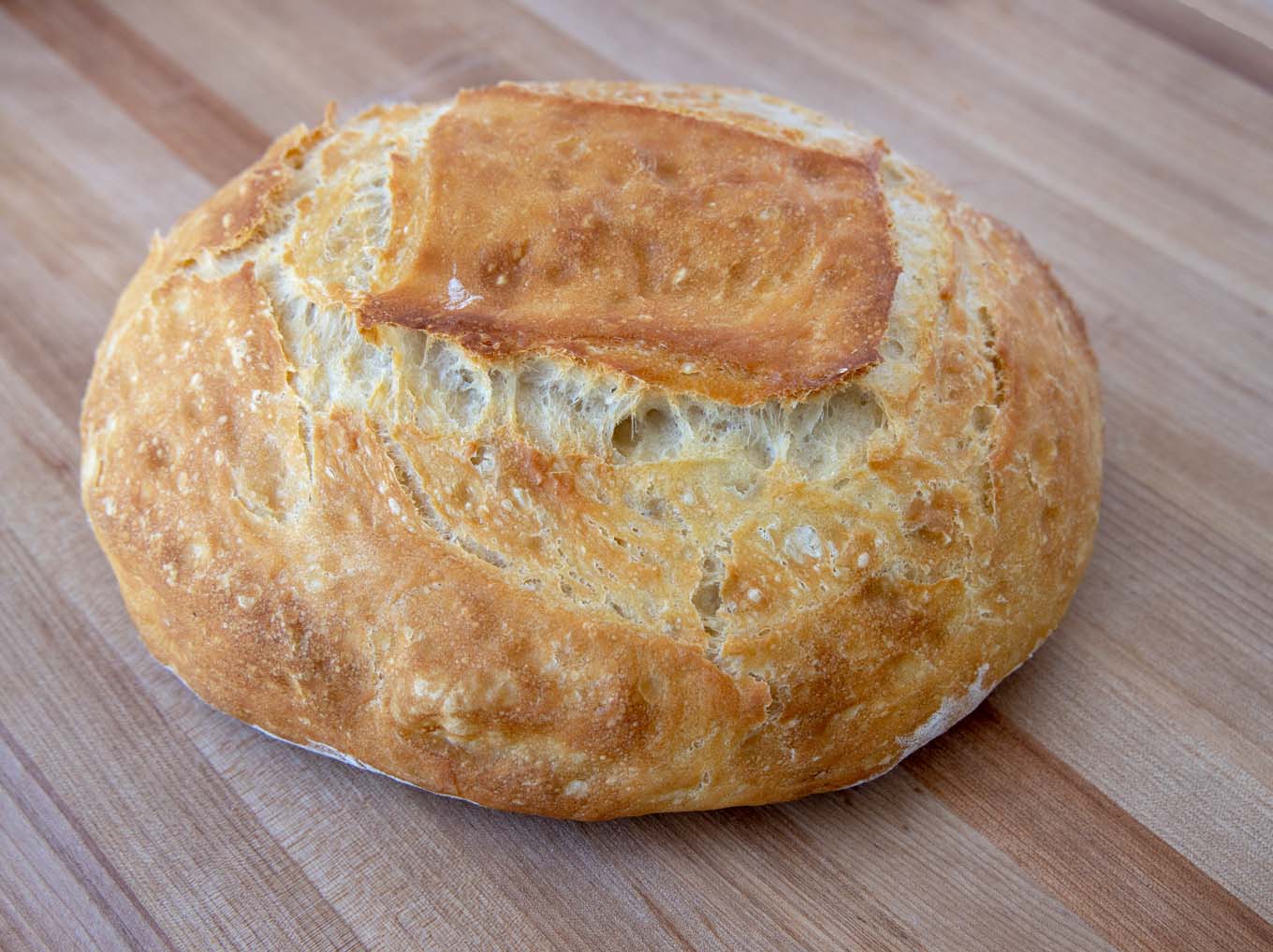
I’ve experimented with different quantities of yeast and salt. I’ve added sugar, honey, and other types of flour to the recipe in my quest for the perfect no-knead bread recipe.
One day, I was watching a sourdough bread video. It was way too much work for a loaf of bread, but the technique used to knead the dough intrigued me. So, I thought I would try that method with my much easier-to-make no-knead bread recipe.
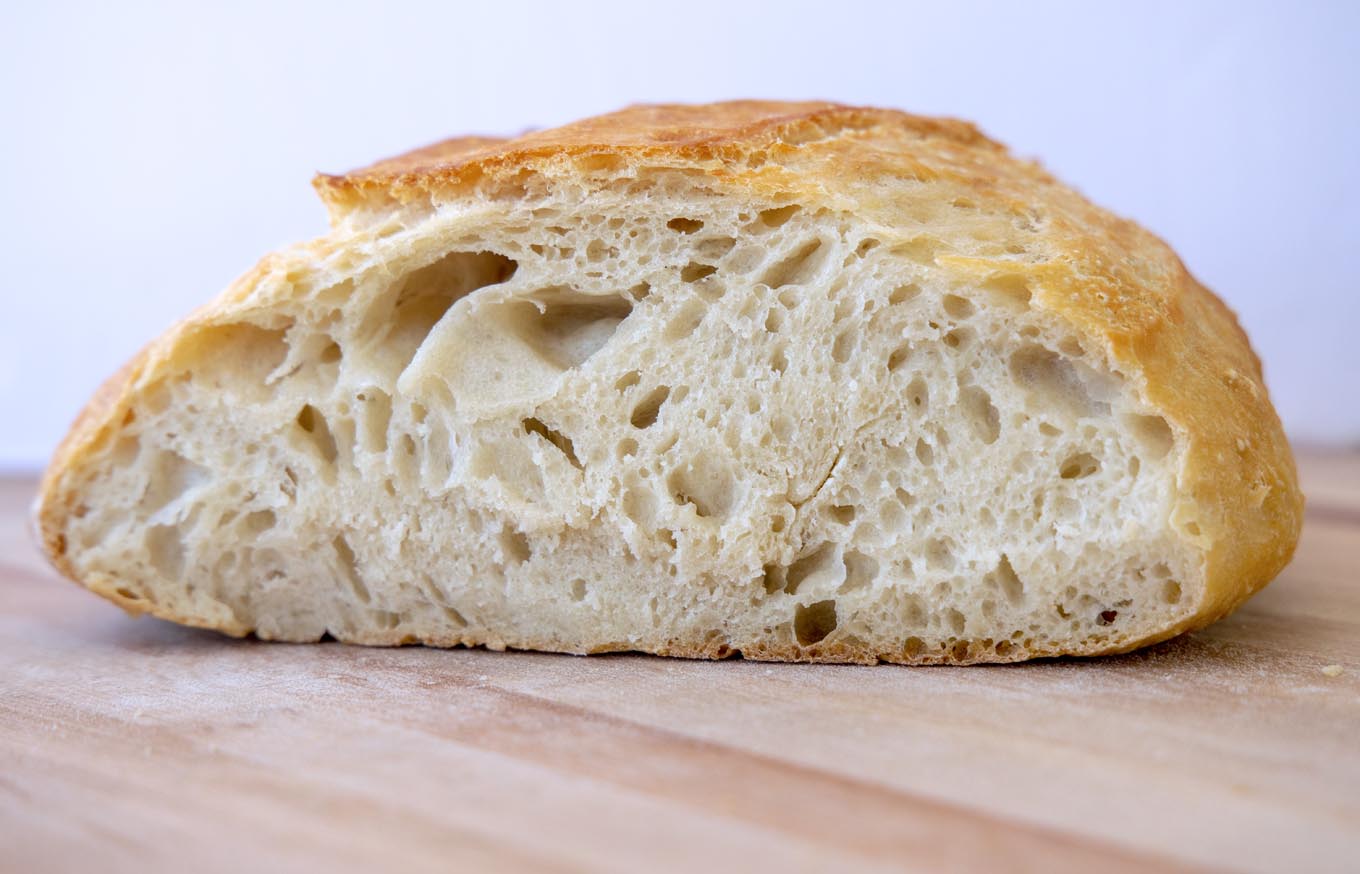
And it was amazing! The results finally yielded the bread I’ve been hoping to make for the last 15 years. It does require a small amount of kneading, but it’s pretty darn easy to make.
See all those little air holes? That’s what I’ve been missing in my no-knead bread all these years! It has a nice crisp crust, a lighter texture, and a wonderful flavor.
Ingredients to make Artisan Bread?
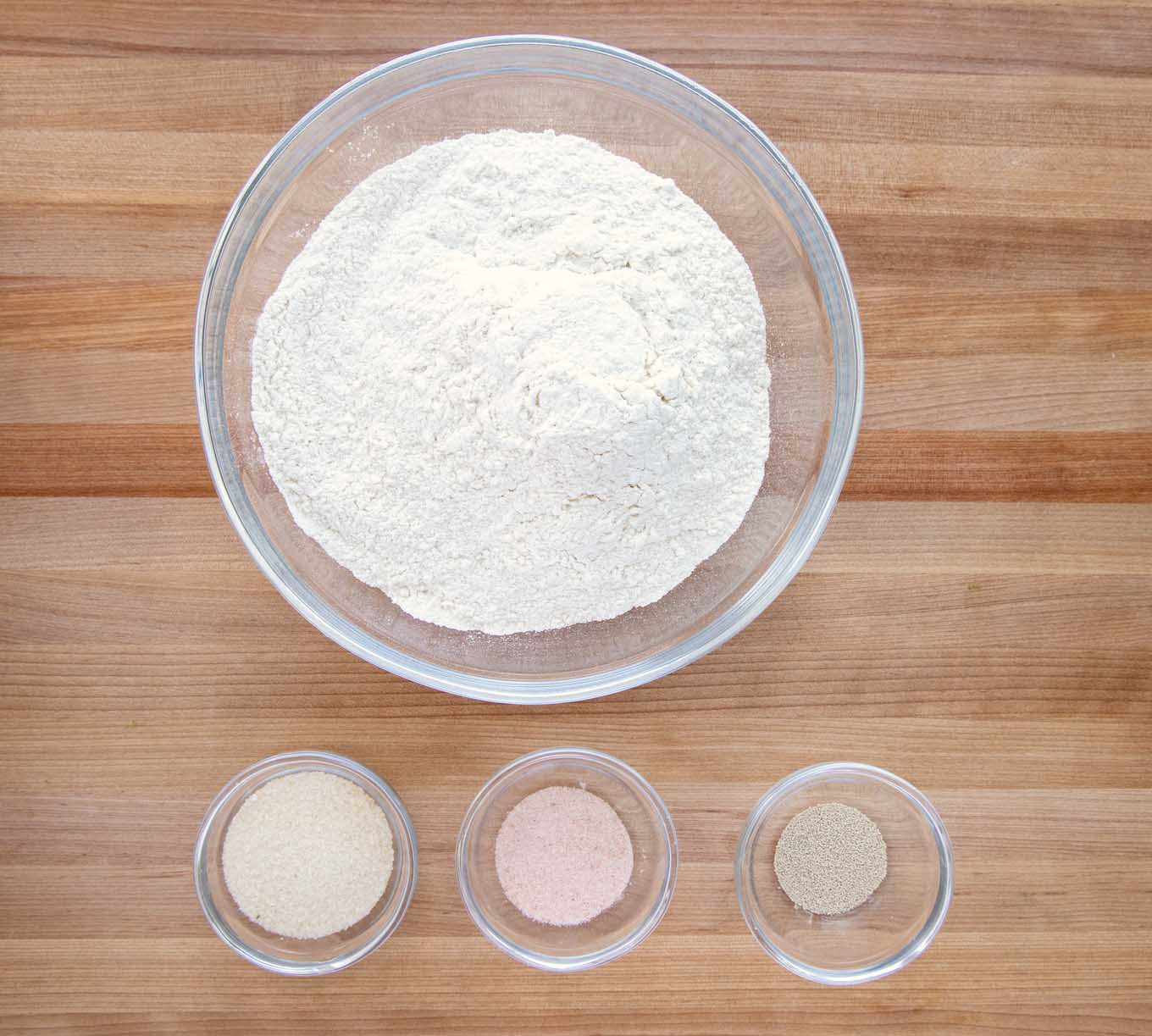
It’s a very short list of ingredients to make this perfect loaf of homemade artisan bread. All-purpose flour, sea salt, yeast, and sugar are the only ingredients you need.
I use Sherpa Pink Himalayan Salt in my kitchen. The other products I use are King Arthur Flour, Active Dry Yeast and Natural Cane Sugar.
Why do I need sugar in my Bread Recipe?
That’s a good question and one I had pondered until I spoke with a master baker about what each ingredient did to make the end result in the bread I wanted.
Sugar has quite a few jobs and provides substantial improvements to yeast bread. It’s not an essential ingredient, but it helps make a better loaf of bread.
- Sugar provides an additional source of food for the yeast. The yeast converts this food to carbon dioxide and alcohol
- Sugar (like salt) enhances the flavor of the bread
- Sugar helps give the crust that golden color we love
- Sugar improves the crumb texture of the bread
- Sugar helps retain moisture in bread and slows down the formation of gluten strands, which helps keep the bread fresher longer
Will sugar make the bread sweet?
That’s a great question, and the answer is no. We are not using enough sugar to make this sweet bread. You won’t even notice it’s in the bread.
Why do I need salt in my homemade bread?
- Salt regulates the rate of yeast activity. It provides a slow and steady rise, which is even more crucial in this semi-no-knead bread. The slower rise gives the yeast time to develop the characteristic bread flavors we love
- Salt also strengthens the gluten structure of bread dough. It keeps the trapped carbon dioxide bubbles from expanding too quickly
- Salt makes bread taste better
How to make Artisan Bread
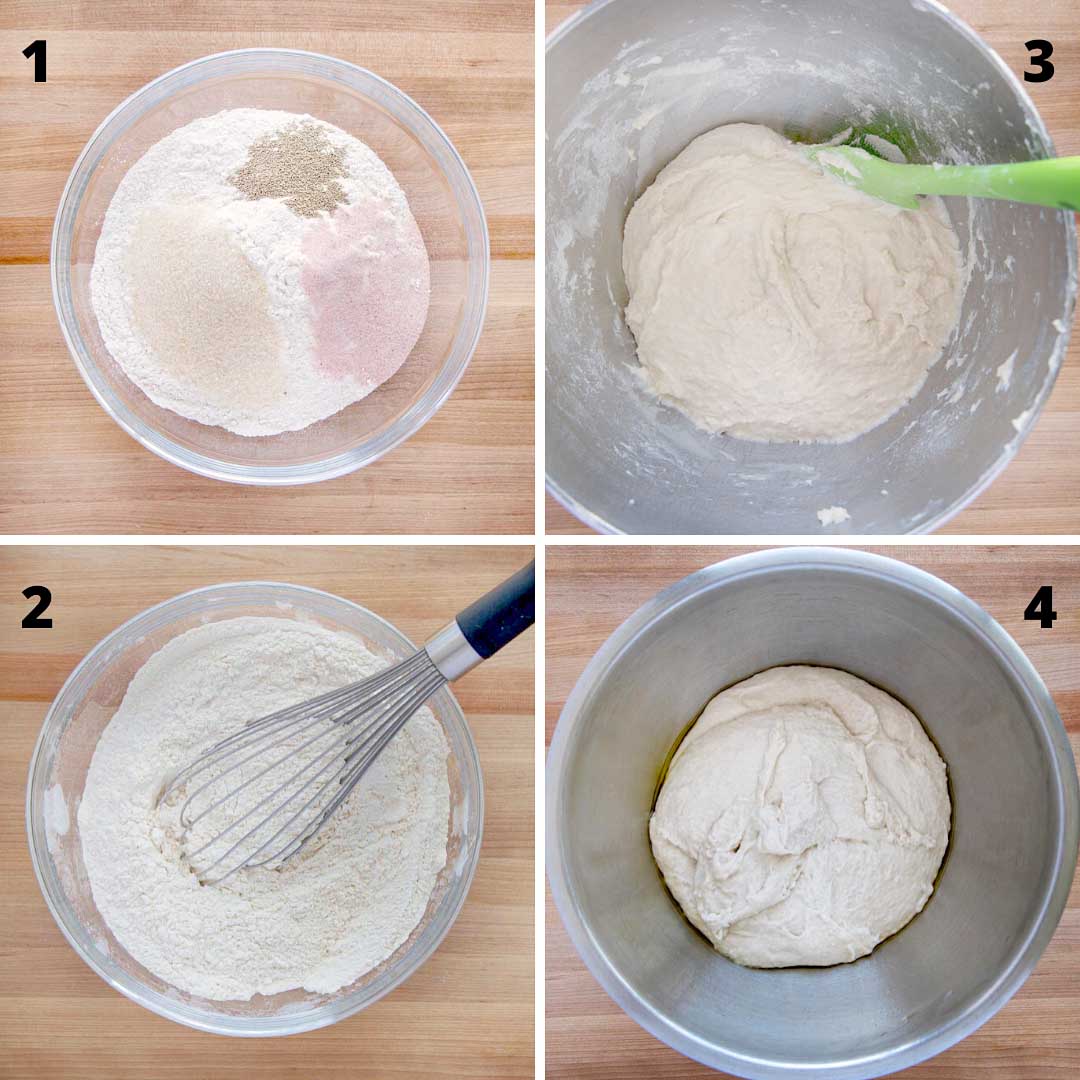
The process is fairly simple. It only takes about 10 minutes to make the bread dough and set it up for the first rise.
Following the recipe, add the salt, sugar, and yeast to the flour, whisking it all together to ensure equal distribution.
Then in a stand mixer (or by hand) add in the water. Depending upon the brand of flour you use, you may need a little less or a little more water. So start with about ¾’s of the water adding more if needed. The dough should be a little wet and sticky.
The last step is to place the bread dough in an oiled bowl and cover it with plastic wrap. Place the bowl on your counter away from drafts for the initial rise.
The rise time will be 12 -16 hours.
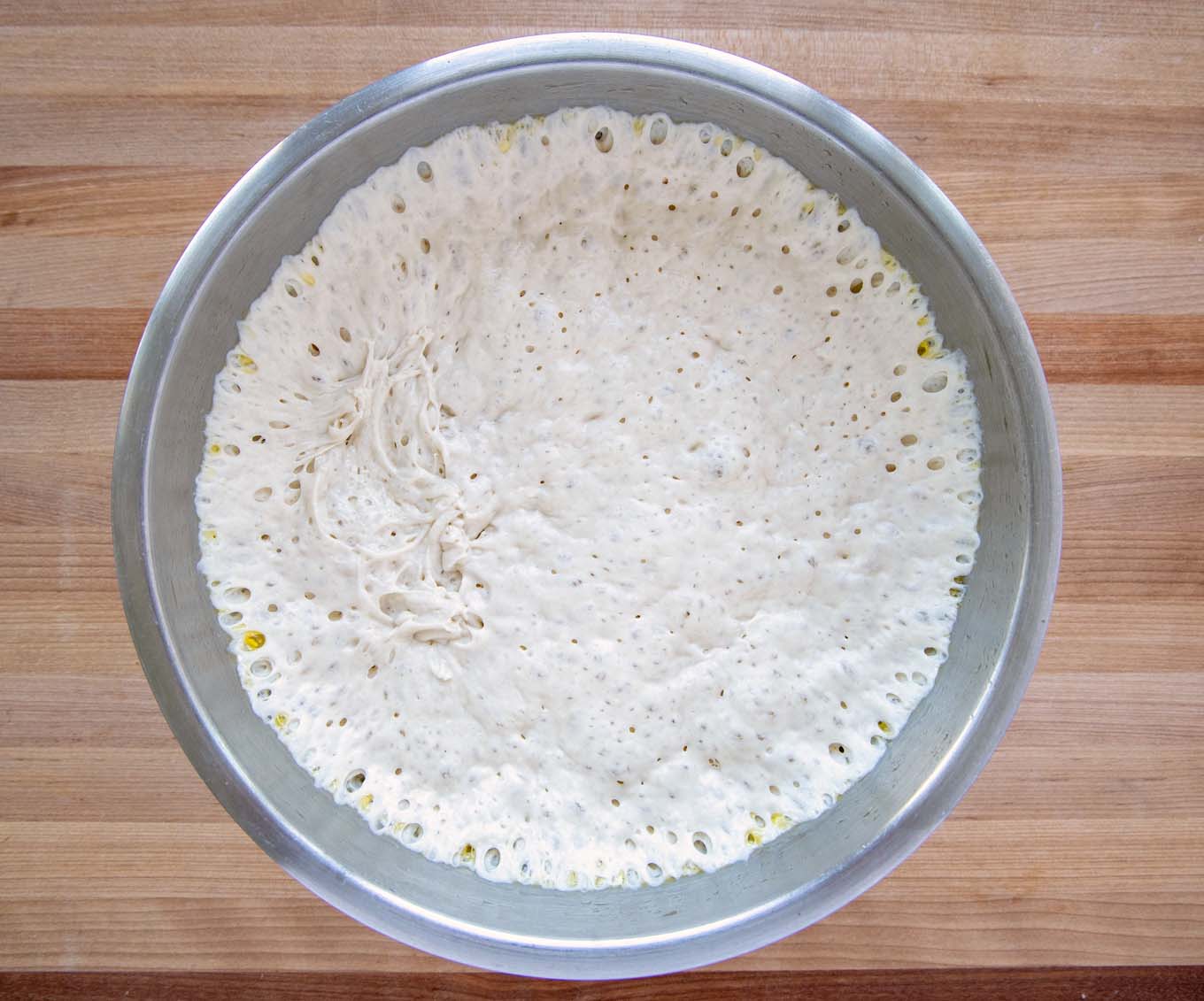
When the first rise is done, the bread dough should look like this. The dough may rise a little more than it falls a little. That’s normal; don’t worry.
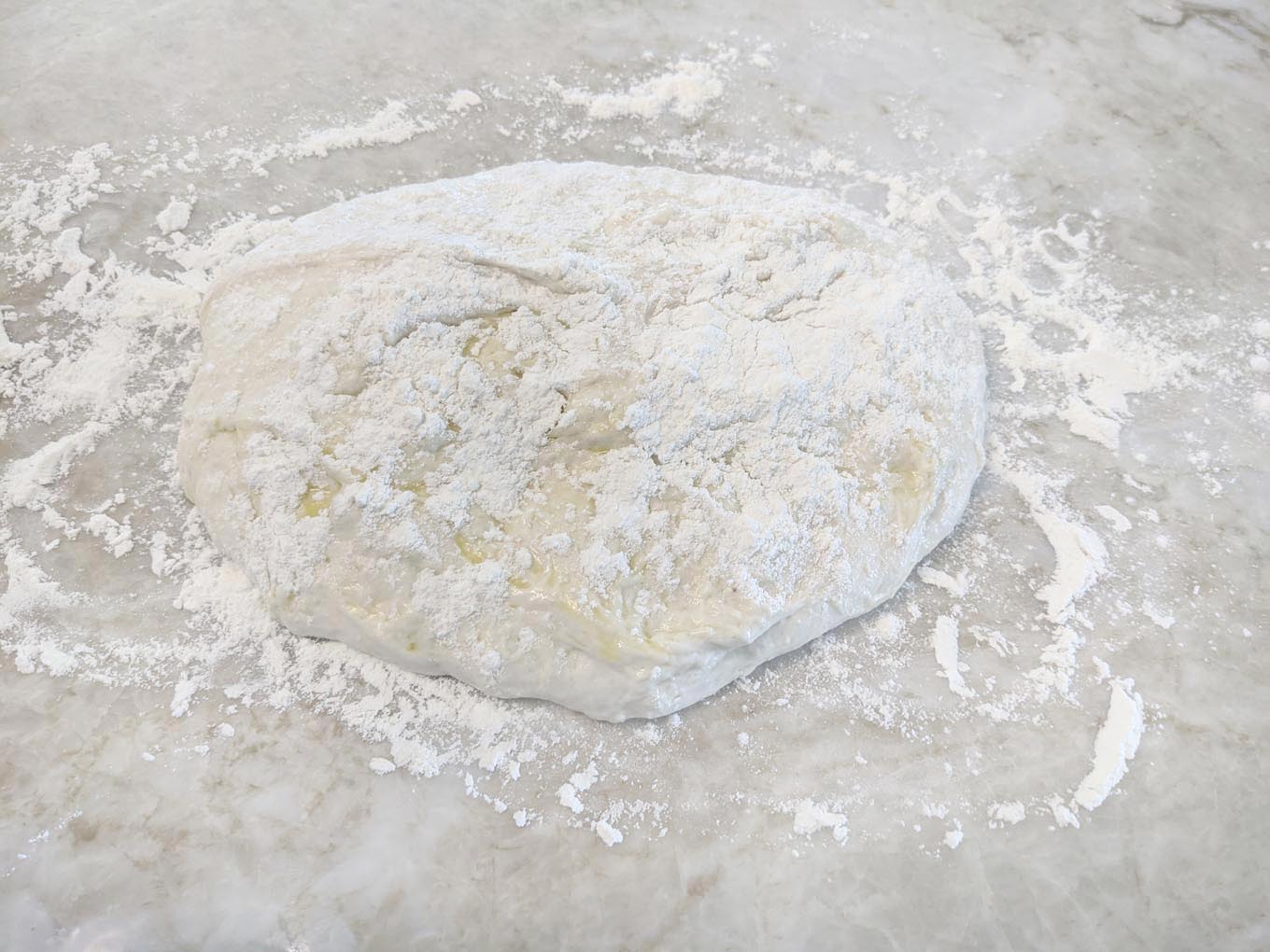
The first step is to lightly flour a countertop and place the bread dough on the floured area. At this point, you will begin adding additional flour until the dough is no longer wet and sticky.
You don’t want the dough completely dry, but it should be easy to work with when you’ve added enough flour. This should take you about 5 minutes.
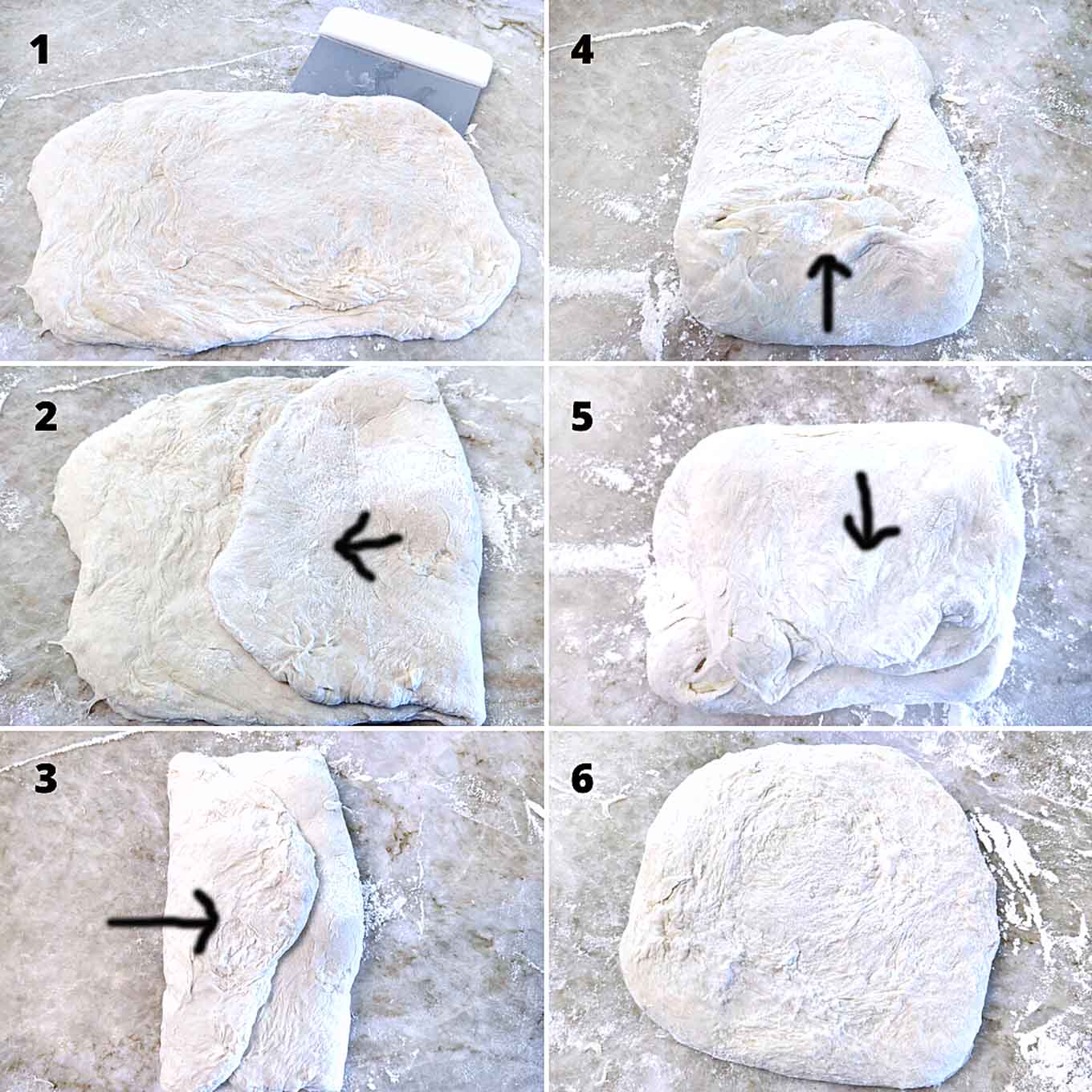
The next steps are the folding process that will give the dough the textures and appearance we want.
- On a floured surface flatten the dough out to make a rectangle
- Fold over ⅓ of the dough to the center (you’re folding the widest part first as shown in the pictures above)
- Fold over the other side of the rectangle overlapping the first fold of the dough
- Continue the folding process by folding the bottom ⅓ of the dough upwards toward the center of the little package you’ve made
- Now fold the top part of the dough down overlapping the fold you just made
- Turn the dough over (seam side down) and make a disc or oblong loaf, depending upon what shape of bread you want to make.
A Dough Scraper or cutter will make the process easier and help move the dough around without constantly touching it.
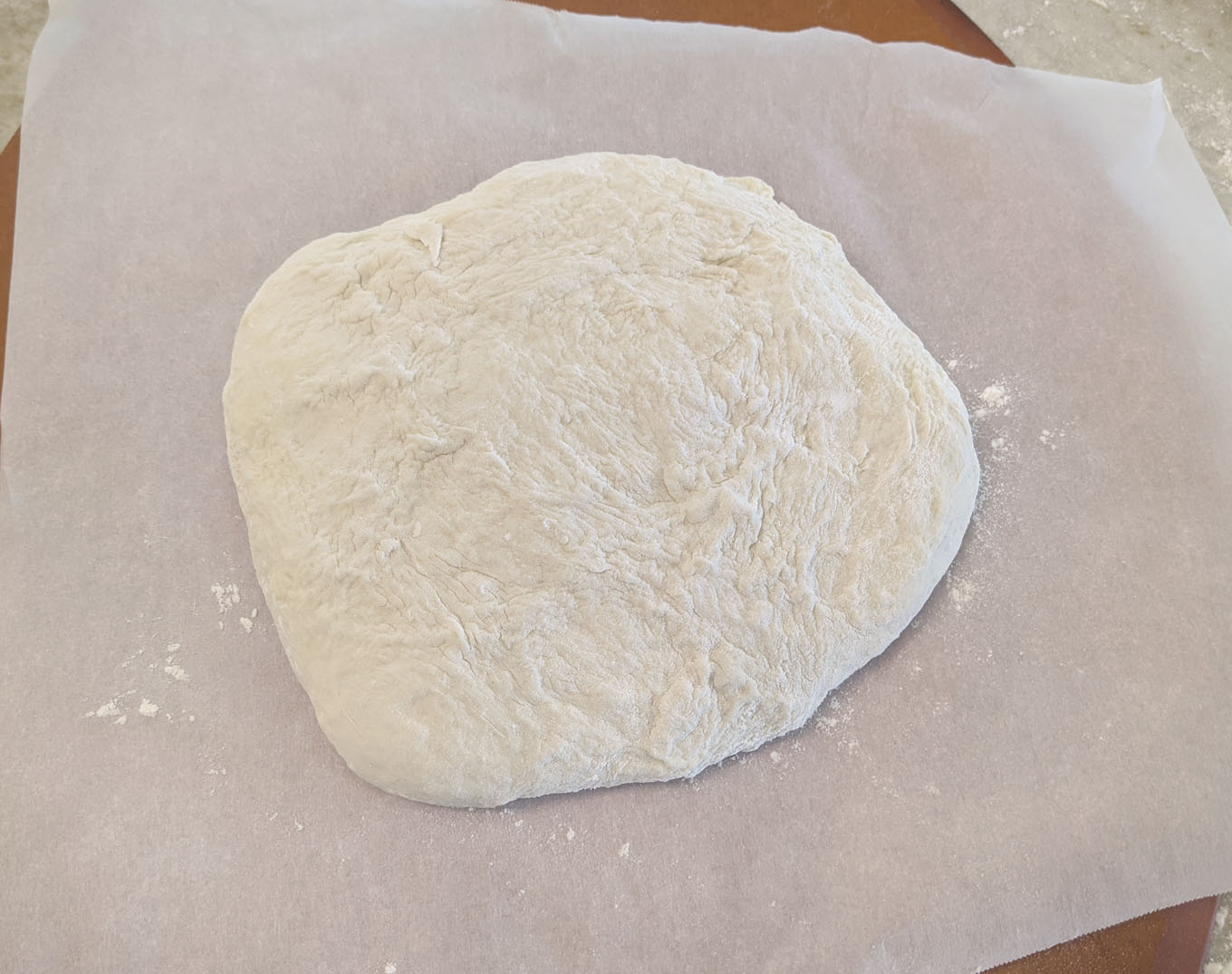
Place the finished dough on parchment paper (sprinkle cornmeal or flour on the parchment before placing the dough)
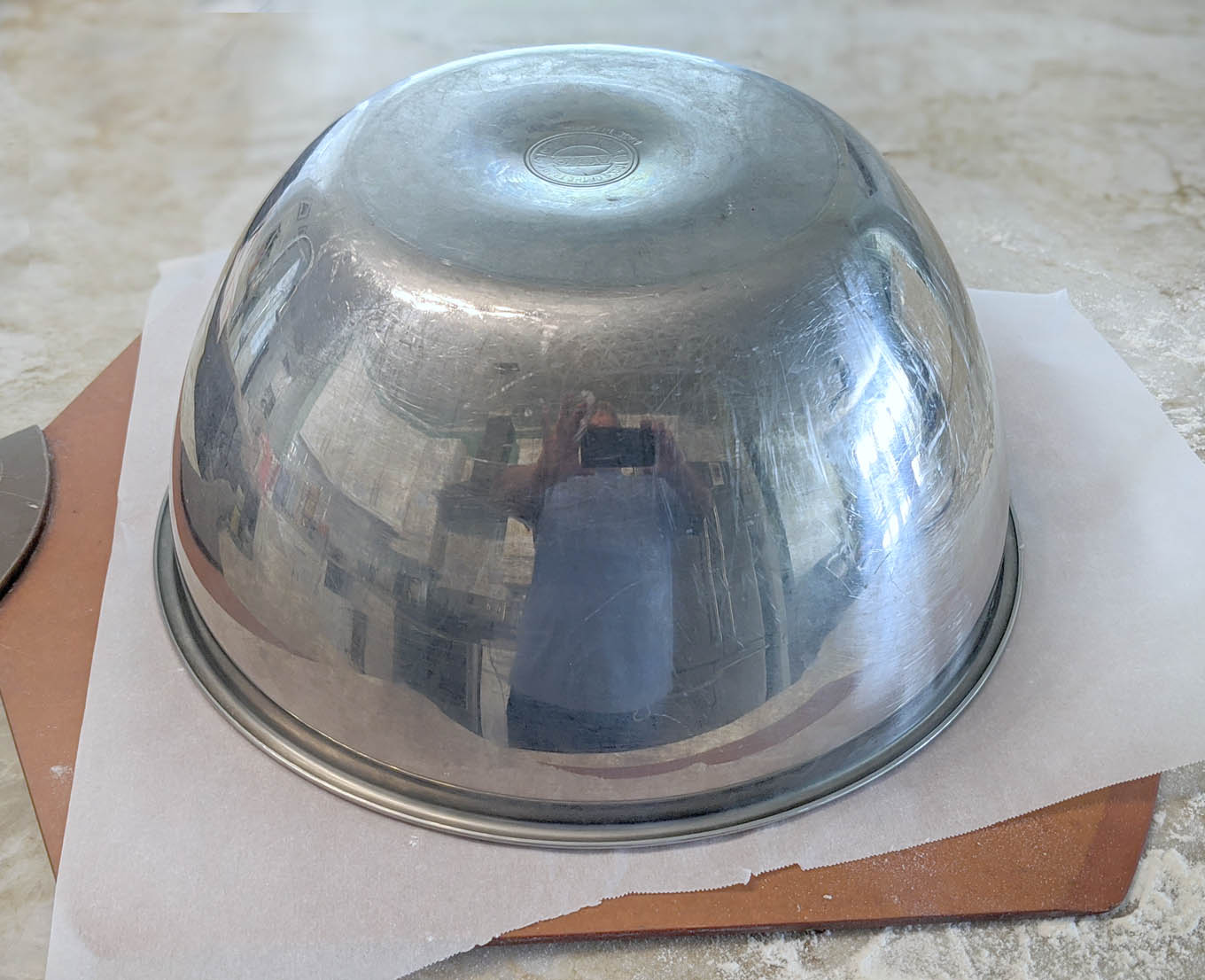
For the second rise, cover the dough with a bowl or damp tea towel. Preheat your oven to 450 degrees F. and place the dough on top of the stove.
The rise time will be 30-40 minutes for the second rise.
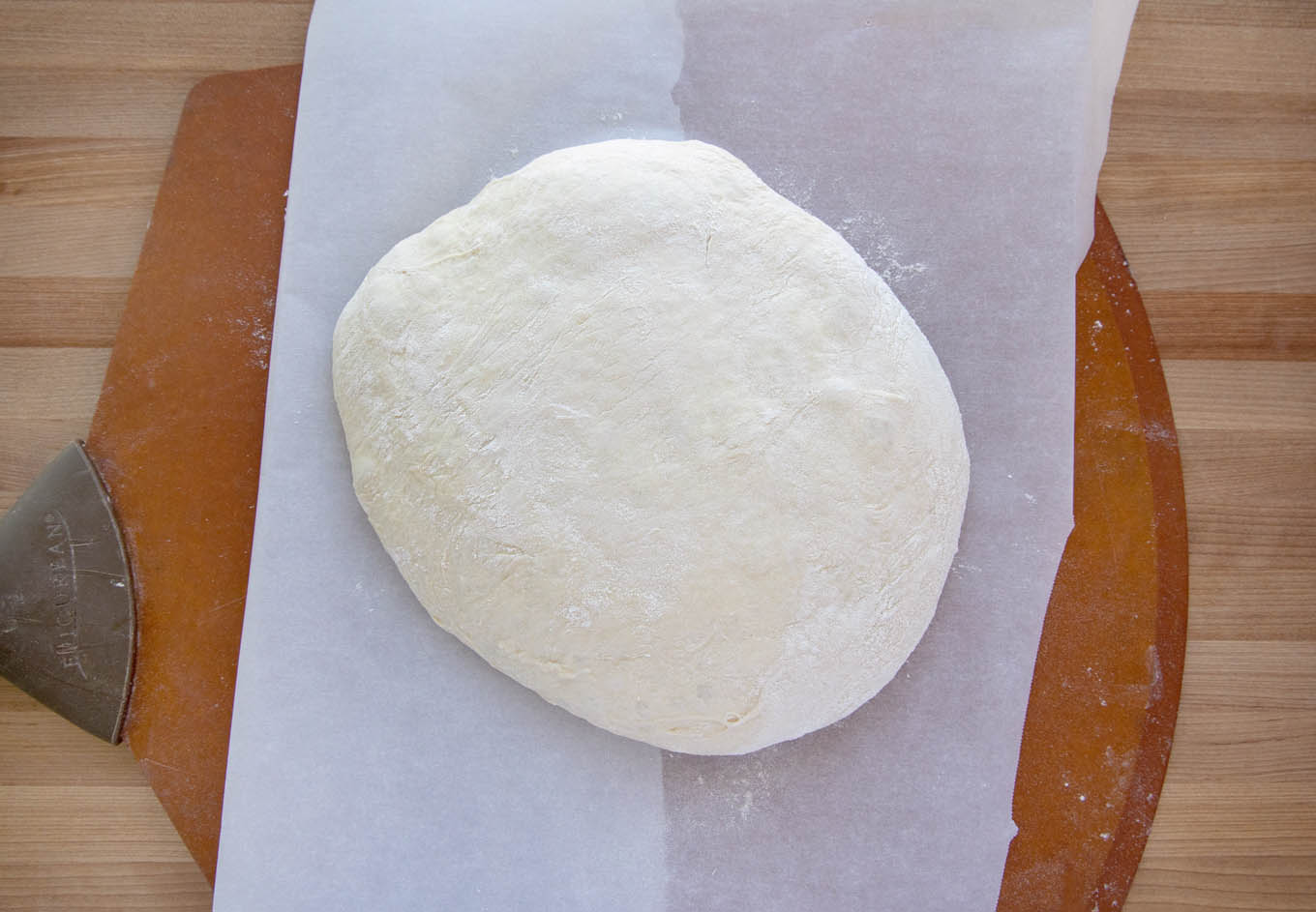
When the bread has finished rising, it should have a pillowy appearance and feel. When you shape the dough, don’t handle it any more than you have to.
The next step is cutting a design (if you want to) on the top of the bread. I used one of my kitchen knives, but they never really make great cuts, so I ordered a Bread Lame and Scoring Tool from Amazon. You don’t really need this, but you know what they say about a boy and his toys.
The last step before placing the bread dough in the oven is to brush it with water. Water helps crisp up the outer crust of the bread, making it crusty, which I love.
- Brush with olive oil for a smooth chewy crust
- Dust the bread with flour for a rustic look and chewy crust
- Brush with melted butter for a softer crust and appearance
- Brush with egg to get a shiny brown crust
**If you want to add seeds to the bread, any of the wet methods will help the seeds stick to the bread.
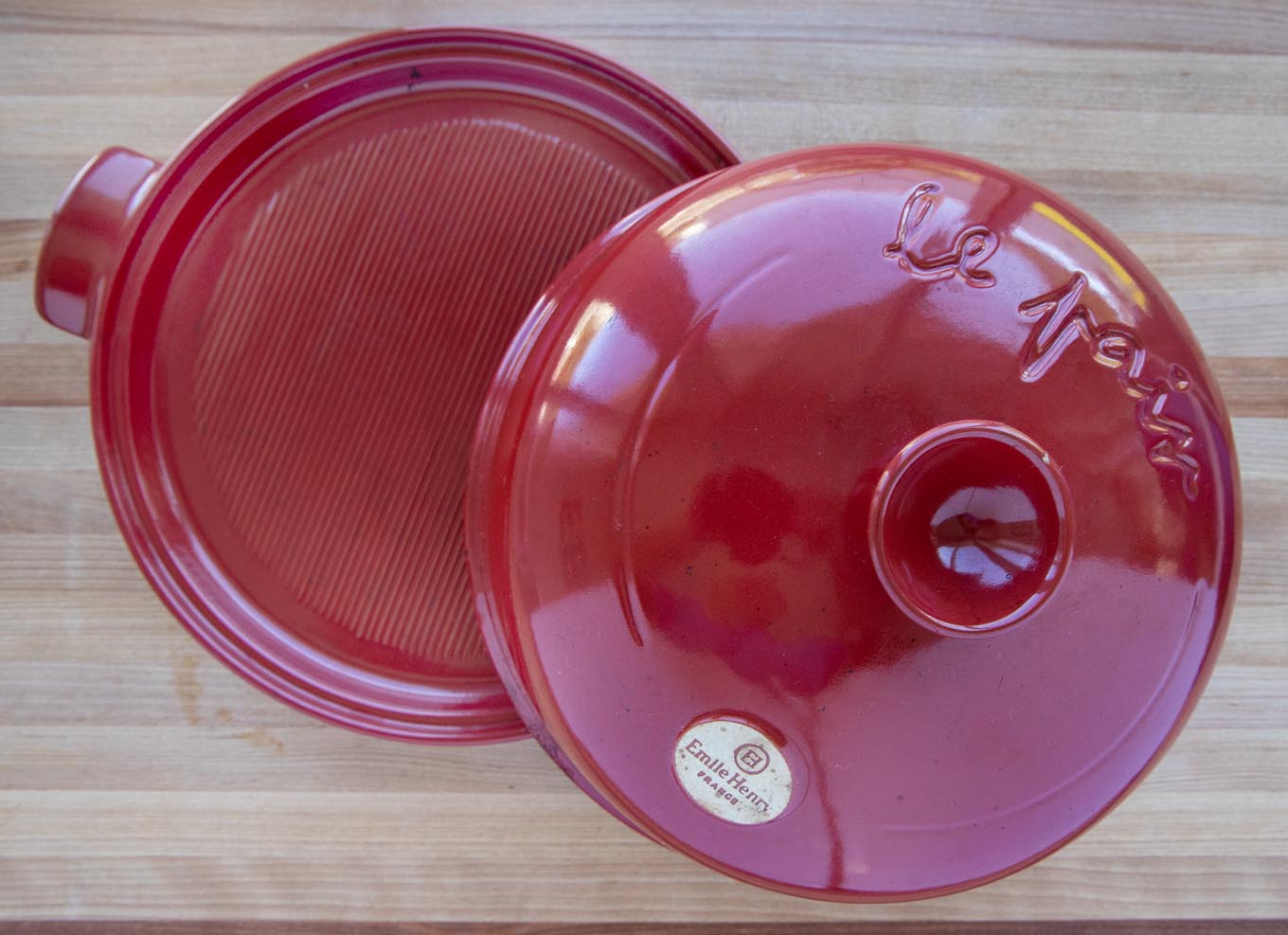
I use an Emile Henry Cloche to bake my bread in. You can also use a Dutch oven for this Artisan Bread.
What size dutch oven should I use to bake this recipe?
To make one loaf from my recipe, you will need a 7 qt. dutch oven or bigger. If you have a 5 qt Dutch oven, you can reduce the recipe by one-third or make two loaves.
What if I don’t have a cloche or a Dutch oven?
If you don’t have a cloche or a Dutch oven, a heavy metal cake pan (round or oblong) will work. If you use a cake pan, you will do your final rise in the pan. The bread will come out a little darker because it won’t be covered.
Recipe FAQ
Bread that is mass-produced using large machines is referred to as Supermarket Bread. Artisan bread is usually made by hand using longer and more traditional processes.
My side-by-side tests showed that my folded no-knead bread had a rounder, more appealing flavor and had a better balance between acid and sweet than the loaves without folds.
The main reason your bread isn’t crusty is moisture, which comes from inside the bread. When cooling, you must give your bread enough room to breathe. Keep your bread on a cooling rack with enough space under it.
after my bread has cooled, I give it 7- 10 minutes and place it directly on the center rack in a 350-degree oven. This crisps the outside of the loaf nicely.
Yes, you can, but not using this recipe. Bread flour has a higher protein count which means the ingredients would have to be adjusted to accommodate using bread flour.
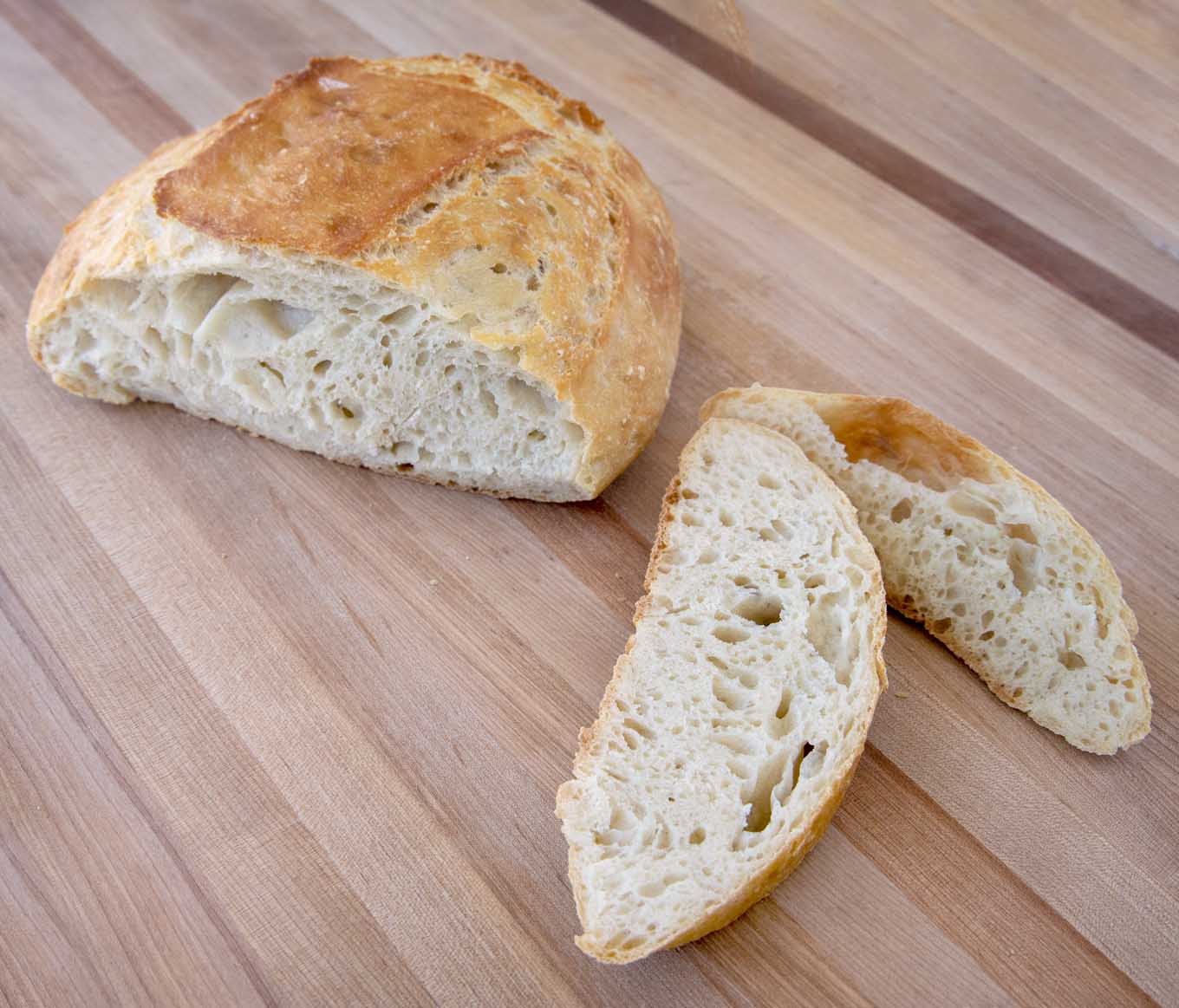
The finished bread is golden brown, crusty, and delicious. Once you get the hang of it, the process will only take minutes.
I keep a ziplock few bags of flour and other ingredients measured out ahead of time. That makes it super easy to make the bread after dinner so it’s ready to bake in the afternoon.

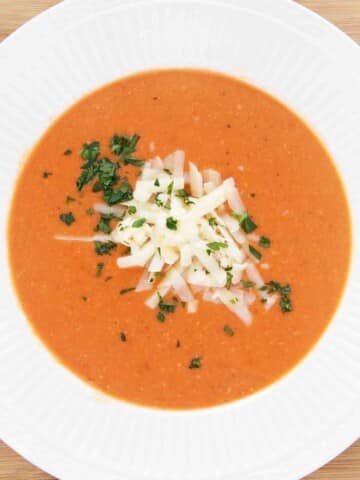
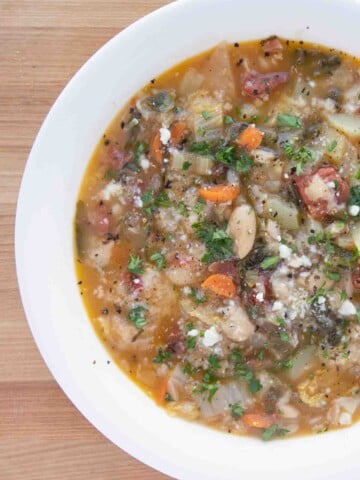
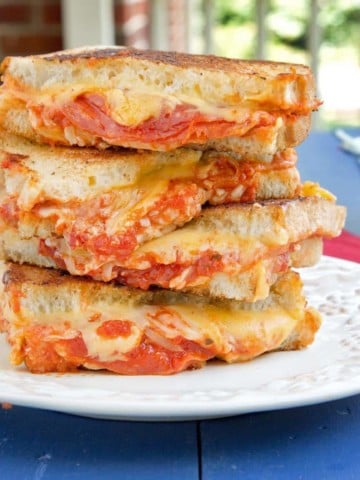
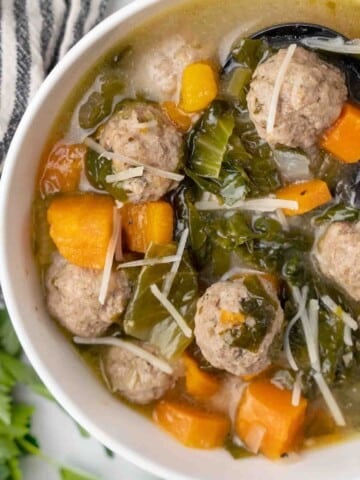
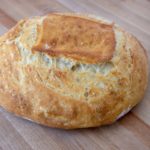
Diane says
This is the 4th recipe I tried to make Artisian bread and was about to give up, then I gave your recipe a try and voila’! It came out just like yours! I am so impressed with your excellent directions! Been kneading bread for more years than I care to say so it was hard for me to not knead the flour in but it worked! Thank you so much for your step by step instructions. Wonderful taste and will definitely be making it many times more. Thank you! 🙂
Chef Dennis Littley says
Thank you for taking the time to let me know my recipe worked for you. It has become my go-to bread recipe. It did take quite a few years and unsatisfactory loaves to get there, but I’m happy the results and comments like yours make it all worthwhile.
I hope you find more recipes on my blog to try!
Biff says
Thanks Dennis! You Sir, have made a bread baker out of me!
Your recipe is my first attempt at baking bread ever and it was stumbling on your blog that convinced me to give baking a try in the first place… and it came out great! (by my standards). Especially, considering I misread the recipe the first time and only put in 2 tsp of sugar instead of 2 Tbsp. I did correct that on my second loaf and it did rise a decent amount more in the 14 hours I gave it.
Even my French, country-side raised wife, who is very particular about her bread, said it was “not bad”. Despite her assertion that adding sugar to bread is akin to sacrilege (you should’ve seen the face she made). Now, I will see if more practice baking this recipe will win her over enough for her to say she actually likes it. Then, it will be on to the French mother-in-law test!
The only real criticism my wife had (apart from the usual ones I get whenever I am in the kitchen), was that it was a little dense. And so, I have a question about that.
Currently, I am using a Bob’s Red Mill, Unbleached, Organic All-Purpose with 10%-12% protein. Would switching that up to a flour with a better defined protein content or tweaking the amounts of any of the other ingredients encourage a significant decrease in the sensation of denseness?
Also, a bonus question, when doubling the ingredients of the recipe to make one larger loaf, does the cooking time stay the same?
Thank You again Dennis! You have certainly helped me discover a new, tasty hobby and another great way to maintain domestic… ahem… bliss 😉
Chef Dennis Littley says
Thanks for the great rating and the comment Biff. By no means does this bread measure up to French Countryside bread as isn’t needed. The tradeoff with this type of bread is while it’s easier to make it’s generally denser. The folding actually helped out a lot, before that it was really dense!
was the water around 70 degrees, too hot can be a problem and too cold as well.
was the dough sticky and wet when it came out of the mixer? Too much flour can cause it to be dense.
was the yeast old? The only reason the sugar is in the bread is to help activate the yeast, if the yeast was old that could also be an issue.
The flour shouldn’t be a problem, I use King Arthur which has 11.7% protein so the Bob’s Red Mill should be okay. Originally I was told you needed to use a lower protein flour for no-knead but I’ve always used whatever I had on hand which was mostly King Arthur.
As for doubling and making a bigger loaf, I have never tried that, but as long as the loaf is longer and wider, it shouldn’t affect the cooking time too much, maybe 5-10 minutes longer. I always judge it by the color of the crust.
Are you using a cloche, dutch oven or just a baking sheet? If you are using a baking sheet/ or stone try adding a pan of water into the oven before placing the bread in to add a little steam, this sometimes helps.
hope this helps, and I hope you find more recipes on my blog to try!
Dennis
Biff says
Hi Dennis, Thanks for the quick and helpful reply!
So, I am clearly a total noob. I looked on the yeast package and yes, it is old. Expired August 2019. I will not make that mistake again.
The water temp I did check but it was more like 65-67 degrees. Next time I will see if I can bring that up a little.
Dough was indeed quite sticky and wet in appearance so hopefully I have that dialed in, but I will continue to pay attention.
I am currently looking into a cloche, but using a dutch oven for now. And I get what you are saying making a larger loaf by needing to keep it about the same height by making it wider and longer.
I was actually thinking of doubling the loaf so as it cooked in our 6.5 qt dutch oven it would maybe meet the sides and then be forced to be a little loftier to make better toaster sized slices, but now I am second guessing that notion (may still try it though for a learning experience 🙂
Also, I now realize this recipe can’t be everything thing to everyone. Thinking it could replace the bread my wife grew up with was maybe un tout petit peu unrealistic. However, I still hope to learn to make this recipe well enough for her to enjoy it, and then use that education to improve my bread baking enough to get good at making a traditional French countryside bread (this is where my wife says, “knock yourself out, mon cheri”). I am looking forward to the adventure. Thanks for helping me along my way.
Tiramisu! That is the next of your recipes I want to try, but then something more savory perhaps. Tough choice though as you have so many I would like to try. Suffice it to say, I will be spending a good amount of time on your blog since you make your recipes seem so doable to such a kitchen novice like me.
Cheers!
Kristi says
I am making this bread now. What do you do if you add too much water?
Chef Dennis Littley says
You could just add more flour and hope for the best, the recipe is a little forgiving. Just understand that the finished product might not be as good as it could have been.
Clair says
Do you think there is a way to achieve a similar texture using more whole grain or even artisan flours, I have a few from “Janies Mill” that aren’t white flour, but wondering if a mix of all purpose and a whole red wheat (from Janies Mill” would be able to achieve similar holes/texture?
Chef Dennis Littley says
it definitely is possible, but you’ll need to adjust the recipe to reflect the change in the amount of protein the flours you’re using contain. I use King Arthur which has a protein count of 11.7%. Any flour that you have at that percentage should technically work with this recipe. If its got a higher or lower protein count, the amount of water will need to be adjusted.
bibi says
Can you use bread flour instead of all purpose flour, or half and half bread and all purpose flour?
Chef Dennis Littley says
bread flour has a higher protein count than all-purpose and will affect the recipe. The bread is liable to come out dry and dense using bread flour.
Veronica Dare says
This is a GREAT recipe! No fail. I’m making a fourth loaf in 6 weeks. Everyone is impressed with the presentation and taste and I love that it is SO easy! Thank you!
Aileen says
I did it !! Thanks for all the tips and explanations- I added the sugar and my bread wasn’t sweet, and I sprayed the dough with water and it was fabulously crusty! Yay! My only problem was that my dough did not roll into a nice rectangle like yours did… it kept bouncing back into place instead of staying stretched out..? Not sure why? But I folded it the best I could and it came out delish! It didn’t take long to bake and I let it rest for 30 minutes on a rack on top of the stove and when I served it, it was still warm ! It has a really good flavor- thanks Chef Dennis
Chef Dennis Littley says
It’s a learning process. I’ve been making that bread for a long time, so I probably make it look easier than it is. But now that you’ve found the joy of making your own bread, I’m sure it will get easier! Warm bread is a wonderful thing!
Jane says
Great recipe!! I’m trying to split dough in half, baking in 2 quart Dutch ovens. It’s working okay. Is it hindering the quality of the bread using the 2 quart size? Should baking time be less? Thank you!
Linda says
Hi Chef Dennis
Love your thorough instructions. Would quick rise instant yeast still work in the same proportions?
Chef Dennis Littley says
instant yeast will work, you’ll get a faster rise and it can be added directly into the liquids.
Natalie says
Great recipe. The bread turned out perfect. Thanks for sharing this recipe and all the tips and instructions which were super easy to follow.
Leslie says
There is just nothing better than homemade baked bread! You have no doubt perfected this recipe, it was amazing!
Stine Mari says
I loved your FAQs! It helped my bread come out perfectly crusty the way I love it!
Amy Liu Dong says
This was so easy to make and delicious.
Everyone loved it. Thank you!
Jere Cassidy says
Thanks for much for the low-down on this bread, and the reasons to use sugar. I love the folding method you use and it makes sense. I am personally done with sourdough and going back to just yeast. I need a dutch oven like you have.
Mariah says
Hi Dennis! I’ve made this recipe twice now. The first time I added sugar, but I’m super sensitive to sugar and it tasted sweet to me. Since yeast can activate with the sugar/carbohydrates present in flour, I omitted the sugar the second time and it rose just fine and tasted better (for me!). I also did 1/3 less recipe the second time, using 2 cups of flour instead of 3 for a smaller loaf. Just wanted to let you know that it turned out OK without sugar! It’s such a simple recipe, I love being able to just whip it together before I go to bed. I might tackle sourdough again sometime, but it was pretty labor-intensive. Will definitely be making this recipe often. Thank you!
Chef Dennis Littley says
hi Mariah
I’m happy to hear the bread recipe worked for you and it was easily adaptable. You really don’t need the sugar it just helps get a faster rise.
I’m with you on sourdough, I’d love to make it but don’t want to invest the time, especially when this bread is so good!
Judy Hovis says
Can I include add-ins like dried cranberries and chopped walnuts?
Chef Dennis Littley says
you sure can. You want to add them in before the folding process, before the final rise.
Dee says
Great and easy to follow recipe, the bread came out delicious! Love your notes about the sugar and salt
Selma says
Chef Dennis, I used your Artisan Bread recipe today and it was a hit! I have been planning this day for weeks, today was our first cool day in South Texas. I made your bread for lunch with Broccoli and Cheese Soup in my Ninja Pressure Cooker. Your recipe was so easy to follow, and I loved the photos you provided. Since my Dutch Oven is a 5.2 quart size I made two loaves.